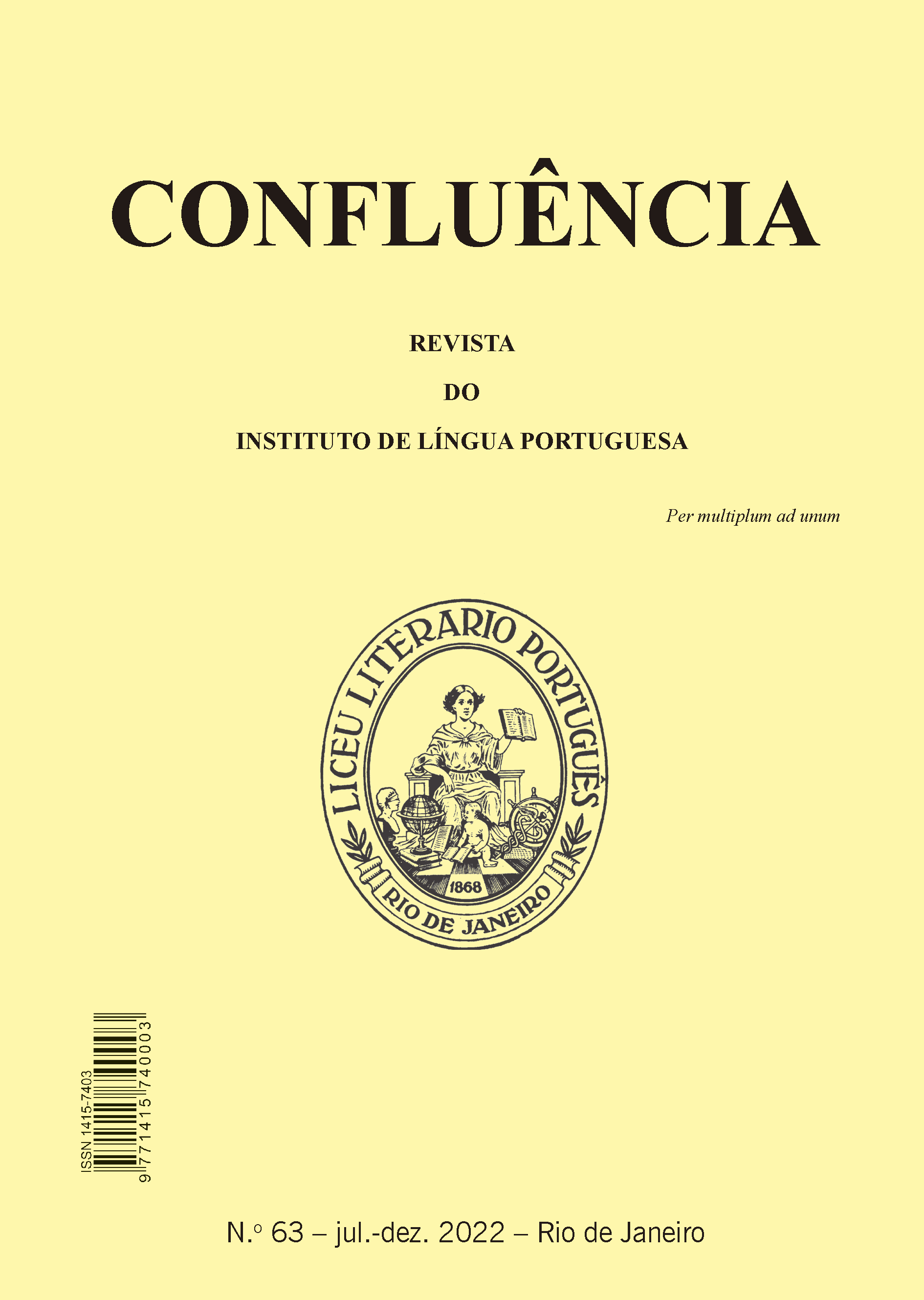Grammatical gender assignment by Portuguese non-native language learners in suffixed words
DOI:
https://doi.org/10.18364/rc.2022n63.540Keywords:
Grammatical gender, Lexical acquisition, Suffixation, Derivation, Portuguese as a non-native languageAbstract
This study aims to investigate to what extent the grammatical gender assignment of suffixed nouns by learners of European Portuguese as a non-native language (PNNL) varies according to the suffix and, more specifically, its formal class and the gender’s marker associated to them. The empirical basis of this study was drawn from a survey, in which late learners, native speakers of Chinese, who attend classes of different levels of learning (from B1 to C1), were asked to explicit the nominal gender value of suffixed nouns in -ção, -s[z]ão, -ão, -agem, -idade and -ice. Identical patterns were found at all levels of learning, but there is a notable incidence of deviations in suffixed forms in -ão and -ice. These results show that the assignment of nouns to genders depends on the degree of representativeness and opacity of the suffix in the input and its associated gender value.
Downloads
References
ALARCÓN, I. The sequential acquisition of L2 Spanish gender marking: Assignment and agreement. Indiana University Linguistics Club Working Papers Online, Indiana, v. 4, n.1, p. 1-23, 2004.
AMBADIANG, T.. La Flexión nominal: género y número. In: BOSQUE, Ignacio; DEMONTE, Violeta (Orgs.). Gramática Descriptiva del Español. Vol. III. Madrid: Gredos, 1999. Cap. 76, p. 4843-4913.
BYBEE, J. Introduction. In: BYBEE, J. (Ed.). Frequency of Use and the Organization of Language. New York: Oxford University Press, 2007. p. 7-22.
BRUHN DE GARAVITO, J.; WHITE, L. L2 acquisition of Spanish DPs: the status of grammatical features. In: PÉREZ-LEROUX, A.T.; LICERAS, J. (Eds.). The acquisition of Spanish morphosyntax: The L1/L2 connection. Dordrecht: Kluwer, 2002. p. 153178.
CONSELHO DA EUROPA. Quadro Europeu Comum de Referência para as Línguas. Aprendizagem, ensino, avaliação. Porto: Edições ASA, 2001.
CORBETT, G. G. Gender. Cambridge: Cambridge University Press, 1991.
DAVIES, M. Corpus do Português [CdP]. Disponível em: /. Acesso em: 29 set. 2021.
Coronica troiana em linguoajem purtuguesa: edicion y estudio. Edição de Ana María García Martín. Salamanca. Luso-Española de Ediciones, 1998.
FERREIRA, T. S. Aquisição/Aprendizagem do sistema de atribuição de género nominal em PLNM. 2019. 343 f. Tese (Doutoramento em Linguística do Português: Investigação e Ensino) – FLUC/UC, Coimbra, 2019.
FERREIRA, T. S. A morfologia dos desvios de género gramatical em PLNM. Diadorim, Rio de Janeiro, v. 23, n.2, p. 210-226, 2021.
HARRIS, J. W. The Exponence of Gender in Spanish. Linguistic Inquiry, v. 22, n.1, p. 27-62, 1991.
MARTINS, C. O lugar do input linguístico e metalinguístico em teorias de aquisição/aprendizagem de línguas não maternas. Implicações pedagógicas. In: Volume de Homenagem a Maria de Fátima Sousa e Silva. Coimbra: Imprensa da Universidade de Coimbra, Instituto de Estudos Clássicos, no prelo.
MARTINS, C. Número e género nominais no desenvolvimento das interlínguas de aprendentes de português europeu como língua estrangeira. Revista Científica da Universidade Eduardo Mondlane, Série Letras e Ciências Sociais, vol. 1, n.1, p. 26-51, 2015.
MASTROPAVLOU, M; TSIMPLI, I. The Role of Suffixes in Grammatical Gender Assignment in Modern Greek: A Psycholinguistic Study. Journal of Greek Linguistics, v. 11, n.1, p. 27-55, 2011.
MATTOSO CÂMARA, J. Estrutura da Língua Portuguesa. Petrópolis: Vozes, 1970.
MATTOSO CÂMARA, J. História e Estrutura da Língua Portuguesa. Rio de Janeiro: Padrão, 1975
MOITA, M. et al. Affix Selection and Deadjectival Nouns: a data-driven approach. In: HUMPHRIES, C. C.; KOSSEK, J.; GOMOLA, A. (Eds.). English language, literature and culture: new directions in research. Bielsko-Biała: Wydawnictwo Akademii Techniczno-Humanistycznej, 2010. p. 118-133.
MOTA, M. A. Morfologia do nome e do adjetivo. In: RAPOSO, Eduardo et al. (Orgs.). Gramática do português. Vol. III. Lisboa: Fundação Calouste Gulbenkian, 2020a. p. 2835-2930.
NUNES, J. J. Compêndio de Gramática Histórica Portuguesa. Lisboa: Clássica Editora, 1989.
POPLACK, S.; POUSADA, A.; SANKOFF, D. Competing influences of gender assignment: variable process, stable outcome. Lingua, v. 57, n.1, p. 1-28, 1982.
RIO-TORTO, G. Flexão e derivação: simetrias e assimetrias. Revista Portuguesa de Filologia (FLUC), vol. XXIV, p. 253-289, 2002.
RIO-TORTO, G. (Org.) et al. Gramática derivacional do português. 2. ed. Coimbra: Imprensa da Universidade de Coimbra, 2016.
RIO-TORTO, G.; RODRIGUES, A. S. (2016). Formação de nomes. In: ___________. Gramática derivacional do português. 2. ed. Coimbra: Imprensa da Universidade de Coimbra, 2016. p. 135-240.
RODRIGUES, A.S. Noções basilares sobre a morfologia e o léxico. In: RIO-TORTO, G. et al. Gramática derivacional do português. 2. ed. Coimbra: Imprensa da Universidade de Coimbra, 2016. P. 35-133.
TAFT, M; MEUNIER, F. Lexical representation of gender: A quasiregular domain. Journal of Psycholinguistic Research, vol. 27, n. 1, p. 23-45, 1998.
TUCKER, R et al. The French Speaker’s Skill with Grammatical Gender: An Example of Rule-governed Behavior. The Hague: Mouton, 1977.
WHITE, L. et al. Gender and number agreement in nonnative Spanish. Applied Psycholinguistics, vol. 25, n.1, p. 105-133, mar. 2004.
Downloads
Published
Issue
Section
License
Copyright (c) 2022 Graça Rio-Torto, Tânia Ferreira

This work is licensed under a Creative Commons Attribution-NonCommercial 4.0 International License.
The author who publishes in this journal agrees to the following terms: The author maintains the copyright and grants the journal the right of first publication, with the work simultaneously licensed under the Creative Commons Attribution License that allows the sharing of the work with acknowledgment of the authorship and initial publication in this journal. The author is authorized to take additional contracts separately, for non-exclusive distribution of the version of the work published in this journal (eg publish in institutional repository or as a book chapter), with acknowledgment of authorship and initial publication in this journal. The author is allowed and encouraged to publish and distribute his work online (eg in institutional repositories or on their personal page) at any point before or during the editorial process, as this can generate productive changes, as well as increase the impact and citation of the published work.








